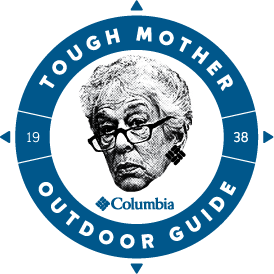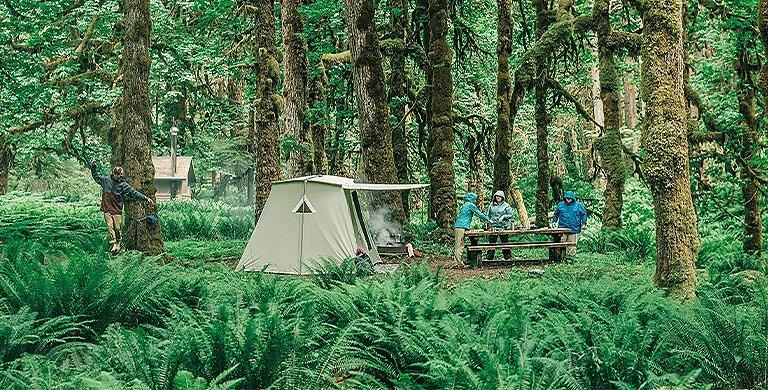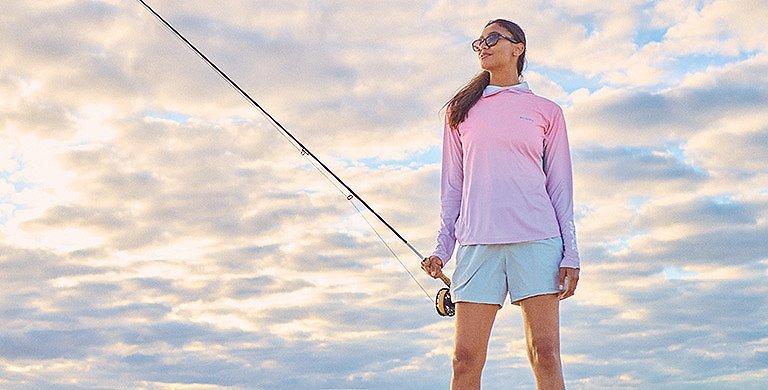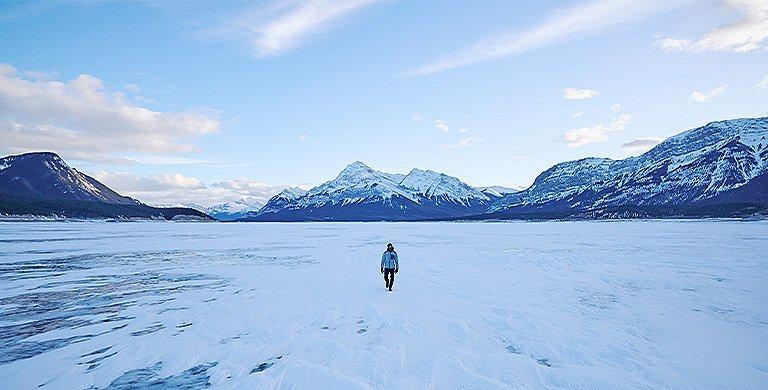
TECHNOLOGY
From Everest to the Moon: Columbia’s Omni-Heat Infinity Tech in Action
Columbia’s Japanese Innovation Team and world-renowned alpinist Kenji Kondo team up to summit Mt. Everest, blending cutting-edge technology and design with elite mountaineering expertise.
BY: NANCY BOUCHARD
Columbia’s no stranger to extreme environments. Known for pushing the boundaries of innovation, Columbia has tested it's technology in some of the harshest conditions on Earth—and beyond. Omni-Heat Infinity, for example, helped protect Intuitive Machines’ Athena robotic lunar lander from space’s punishing temperatures. This advanced thermal-reflective technology, designed to reflect body heat using a pattern of metallic gold dots, enhances warmth while remaining breathable—making it equally effective from the vacuum of space on its journey to the Moon to the icy slopes of Everest. So, it’s no surprise that the same thermal-reflective warmth kept a team of seven climbers warm, comfortable, and safe on their successful Mt. Everest summit bid.
“We started this project because we wanted to convey the image of Columbia as an authentic outdoor brand to the Japanese market,” says Columbia Japan’s Marketing Manager, Satoshi Eto. Columbia Japan’s passion for technical excellence mirrors the global brand’s ethos—proving performance where it matters most. “It wasn’t just about providing gear—it was about proving our technology’s effectiveness in the world’s most extreme conditions,” Eto explains.
“We started this project because we wanted to convey the image of Columbia as an authentic outdoor brand to the Japanese market,” says Columbia Japan’s Marketing Manager, Satoshi Eto. Columbia Japan’s passion for technical excellence mirrors the global brand’s ethos—proving performance where it matters most. “It wasn’t just about providing gear—it was about proving our technology’s effectiveness in the world’s most extreme conditions,” Eto explains.

According to Eto, the collaboration between Columbia and legendary Japanese alpinist Kenji Kondo helped refine and reimagine the brand's offerings. Most people probably don’t need an 8,000-meter kit—the Attack Suit—for their everyday adventures, but the technology has trickled down to products that make a difference for everyone who heads outdoors.
On April 11, 2024, Kenji Kondo led an Adventure Guides expedition to Mount Everest, a quest that would result in his 21st summit of an 8,000-meter peak. His team included Eto, who served as the expedition’s photographer. The team spent 50 days in Nepal, acclimatizing, training, and trekking the infamous “Everest Highway”--the busy route from Lukla to Everest Basecamp--before tackling the summit.
Kondo, who has summited Everest seven times—including a historic winter ascent of its north face—has also led climbs on Cho Oyu, Lhotse, and iconic European peaks like the Matterhorn and Eiger.
In 2013, he pulled off consecutive summits of Everest and Lhotse, cementing his reputation as one of the world’s foremost alpine experts. That same year, he co-designed the original Attack Suit with Columbia’s Japanese team.
But in 2023, armed with fresh technology and new insights, Kondo and the Columbia design team were ready to redefine high-altitude performance. This time, they upgraded the Attack Suit with Omni-Heat Infinity—a thermal tech so advanced, it kept the climbers warm in -30°C temps while staying light and breathable. The Attack Suit let them move quickly, not just survive.
On April 11, 2024, Kenji Kondo led an Adventure Guides expedition to Mount Everest, a quest that would result in his 21st summit of an 8,000-meter peak. His team included Eto, who served as the expedition’s photographer. The team spent 50 days in Nepal, acclimatizing, training, and trekking the infamous “Everest Highway”--the busy route from Lukla to Everest Basecamp--before tackling the summit.
Kondo, who has summited Everest seven times—including a historic winter ascent of its north face—has also led climbs on Cho Oyu, Lhotse, and iconic European peaks like the Matterhorn and Eiger.
In 2013, he pulled off consecutive summits of Everest and Lhotse, cementing his reputation as one of the world’s foremost alpine experts. That same year, he co-designed the original Attack Suit with Columbia’s Japanese team.
But in 2023, armed with fresh technology and new insights, Kondo and the Columbia design team were ready to redefine high-altitude performance. This time, they upgraded the Attack Suit with Omni-Heat Infinity—a thermal tech so advanced, it kept the climbers warm in -30°C temps while staying light and breathable. The Attack Suit let them move quickly, not just survive.

“My key idea was comfort throughout the 50-day expedition,” Kondo explains. The team tested Columbia gear every step of the way—from Kathmandu to the summit—using items like pants, fleece, and shirts from Columbia’s Titanium Collection, along with Columbia Japan’s Wildwood EXP 50L+10L backpack, co-designed by mountain guide, Ban Ito, who accompanied the team for support.
The new Attack Suit featured several unique details. These included harness-friendly pockets, reduced down fill—made possible by Omni-Heat Infinity—for better mobility, you need to see your feet when climbing, making super puffy suits impractical), an interior pocket to keep water bottles from freezing, and a watch window so climbers could easily monitor altitude, physical stats, and oxygen bottle timing.
The standout feature, Omni-Heat Infinity, reflects body heat using gold dots, keeping climbers warm in -30°C temperatures while still allowing for breathability. This was essential as they ascended above 8,000 meters, where every ounce of warmth counts. Designed to be so warm that climbers could nap in it like a sleeping bag, the suit proved critical. "I was warmer, and the new suit made it was easier to move," Kondo explains.
Plus, they looked good doing it. The sleek design and reflective gold details didn’t just turn heads—they reinforced Columbia’s identity as a brand where style and performance meet, even at 8,000 meters. “Other climbers complimented the reflective gold interior—calling it 'cool,' both for style and spirit,” said Kendo.
The new Attack Suit featured several unique details. These included harness-friendly pockets, reduced down fill—made possible by Omni-Heat Infinity—for better mobility, you need to see your feet when climbing, making super puffy suits impractical), an interior pocket to keep water bottles from freezing, and a watch window so climbers could easily monitor altitude, physical stats, and oxygen bottle timing.
The standout feature, Omni-Heat Infinity, reflects body heat using gold dots, keeping climbers warm in -30°C temperatures while still allowing for breathability. This was essential as they ascended above 8,000 meters, where every ounce of warmth counts. Designed to be so warm that climbers could nap in it like a sleeping bag, the suit proved critical. "I was warmer, and the new suit made it was easier to move," Kondo explains.
Plus, they looked good doing it. The sleek design and reflective gold details didn’t just turn heads—they reinforced Columbia’s identity as a brand where style and performance meet, even at 8,000 meters. “Other climbers complimented the reflective gold interior—calling it 'cool,' both for style and spirit,” said Kendo.

In high-altitude expeditions, striking design and color aren’t just about aesthetics—they’re about safety and morale.
Reflecting on the project, Kondo said, “Columbia’s team took all my requests seriously, resulting in outstanding gear.”
There were plenty of challenges on the expedition. Many of the group caught the flu after arriving in Kathmandu. Some were even hospitalized, but the team pushed on to Everest Base Camp at 5,350 meters, where they began their seven-day round trip summit push.
Then came the dreaded Khumbu Icefall—a perilous glacier zone riddled with crevasses.
“It’s a dangerous glacial belt with crevasses opening everywhere,” Kondo says. The team had trained with ascenders and was prepared for harsh conditions, but the reality was worse than expected. The icefall, prone to avalanches, had collapsed further. What once took five hours now took twelve.
But Kondo’s team pressed on, eager not just to summit but to test the Attack Suit in the environment it was made for.
From Camp 1, the climbers continued through higher camps—Camp 2 at 6,450 meters, Camp 3 at 7,300 meters, and Camp 4 at 7,906 meters in the South Col, the final staging ground before the summit.
By May 21, the team reached Camp 4. Many other expeditions, unable to get permits from the Tibetan side, had converged on the Southeast Ridge route, raising fears of bottlenecks near the summit.
Kondo, anticipating the crowd, led his team to Camp 4 early to rest and eat. At 2 PM, they arrived and napped briefly. By 8 PM, they set off for the summit.
The final climb tested not just endurance and focus but also the Attack Suit’s ability to keep them warm and dry in the Death Zone.
Reflecting on the project, Kondo said, “Columbia’s team took all my requests seriously, resulting in outstanding gear.”
There were plenty of challenges on the expedition. Many of the group caught the flu after arriving in Kathmandu. Some were even hospitalized, but the team pushed on to Everest Base Camp at 5,350 meters, where they began their seven-day round trip summit push.
Then came the dreaded Khumbu Icefall—a perilous glacier zone riddled with crevasses.
“It’s a dangerous glacial belt with crevasses opening everywhere,” Kondo says. The team had trained with ascenders and was prepared for harsh conditions, but the reality was worse than expected. The icefall, prone to avalanches, had collapsed further. What once took five hours now took twelve.
But Kondo’s team pressed on, eager not just to summit but to test the Attack Suit in the environment it was made for.
From Camp 1, the climbers continued through higher camps—Camp 2 at 6,450 meters, Camp 3 at 7,300 meters, and Camp 4 at 7,906 meters in the South Col, the final staging ground before the summit.
By May 21, the team reached Camp 4. Many other expeditions, unable to get permits from the Tibetan side, had converged on the Southeast Ridge route, raising fears of bottlenecks near the summit.
Kondo, anticipating the crowd, led his team to Camp 4 early to rest and eat. At 2 PM, they arrived and napped briefly. By 8 PM, they set off for the summit.
The final climb tested not just endurance and focus but also the Attack Suit’s ability to keep them warm and dry in the Death Zone.

Mt. Kangtege can be seen on the way to Everest Highway enroute to Mt. Everest Base Camp.
Near the summit, the team hit the notorious bottleneck: the Hillary Step. This narrow ridge offers only one fixed rope, creating a queue that can turn deadly. In 1996, delays at the Hillary Step contributed to the deaths of eight climbers, many caught in a blizzard above 8,000 meters with empty oxygen bottles.
To avoid this, Kondo had his team ascend later, overtaking slower groups. “We limited our time above 8,000 meters, and our team had the strength to pass slower teams,” Kondo explained. “The technical clothing was critical to our success.” Their tight-knit group dynamic and trust in their gear made the strategy work.
“We proved that our technology, particularly Omni-Heat Infinity, works in the harshest conditions,” Eto concludes. “But more importantly, we showed that Columbia’s gear is adaptable and effective for the most extreme outdoor activities.”
While the Attack Suit isn’t available for general consumers, the tech has already trickled down into jackets that feature the same gold-dot warmth.
Everest may be the highest point on Earth, but for those who summit it, it’s also a proving ground—for gear, grit, and spirit. For Kondo and his team, it was the culmination of months of training, preparation, and trust. Columbia’s gear, forged in the world’s toughest conditions, continues to evolve—bringing cutting-edge tech to every adventurer.
Near the summit, the team hit the notorious bottleneck: the Hillary Step. This narrow ridge offers only one fixed rope, creating a queue that can turn deadly. In 1996, delays at the Hillary Step contributed to the deaths of eight climbers, many caught in a blizzard above 8,000 meters with empty oxygen bottles.
To avoid this, Kondo had his team ascend later, overtaking slower groups. “We limited our time above 8,000 meters, and our team had the strength to pass slower teams,” Kondo explained. “The technical clothing was critical to our success.” Their tight-knit group dynamic and trust in their gear made the strategy work.
“We proved that our technology, particularly Omni-Heat Infinity, works in the harshest conditions,” Eto concludes. “But more importantly, we showed that Columbia’s gear is adaptable and effective for the most extreme outdoor activities.”
While the Attack Suit isn’t available for general consumers, the tech has already trickled down into jackets that feature the same gold-dot warmth.
Everest may be the highest point on Earth, but for those who summit it, it’s also a proving ground—for gear, grit, and spirit. For Kondo and his team, it was the culmination of months of training, preparation, and trust. Columbia’s gear, forged in the world’s toughest conditions, continues to evolve—bringing cutting-edge tech to every adventurer.
Whether your summit is Everest or a local peak, Columbia’s Omni-Heat Infinity Apparel is built to support your adventure. Stay warm, dry, and comfortable—because adventure’s more fun when you’ve got the right stuff.



